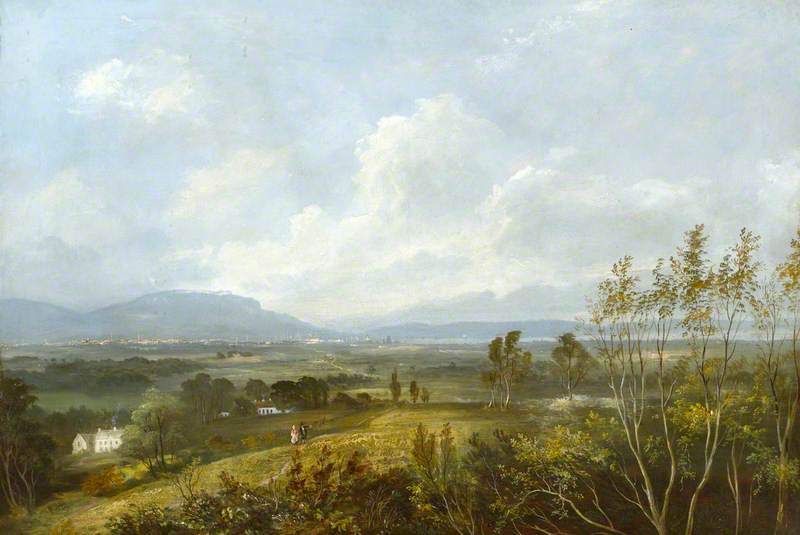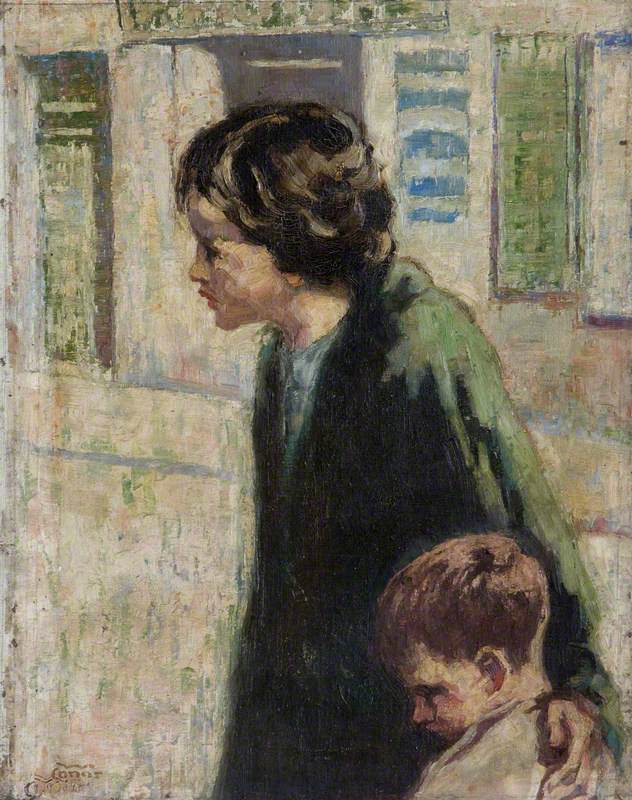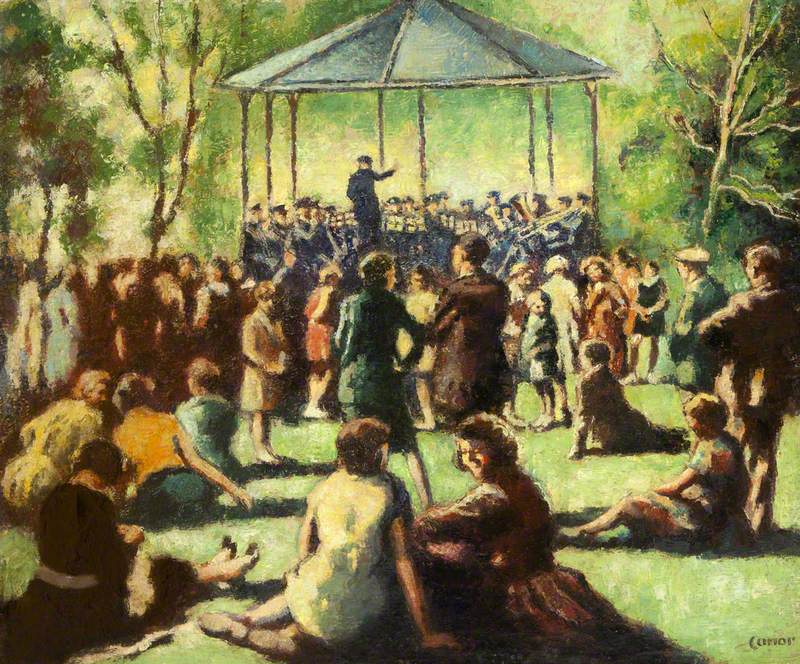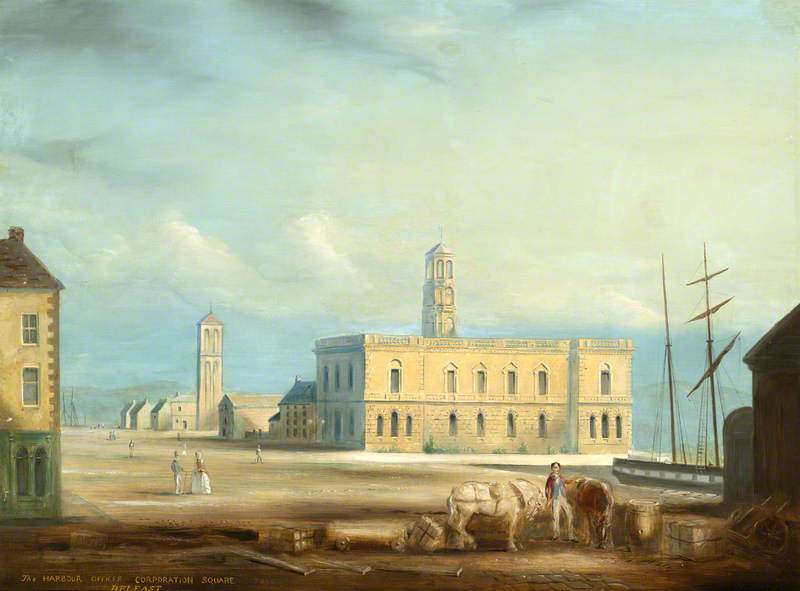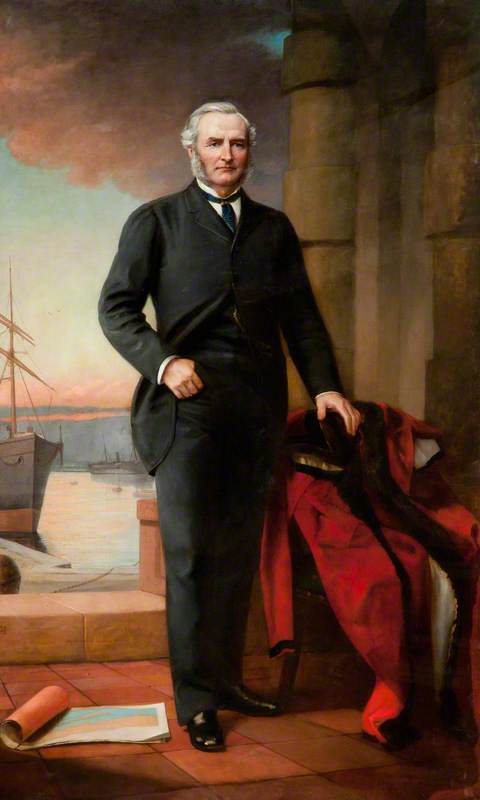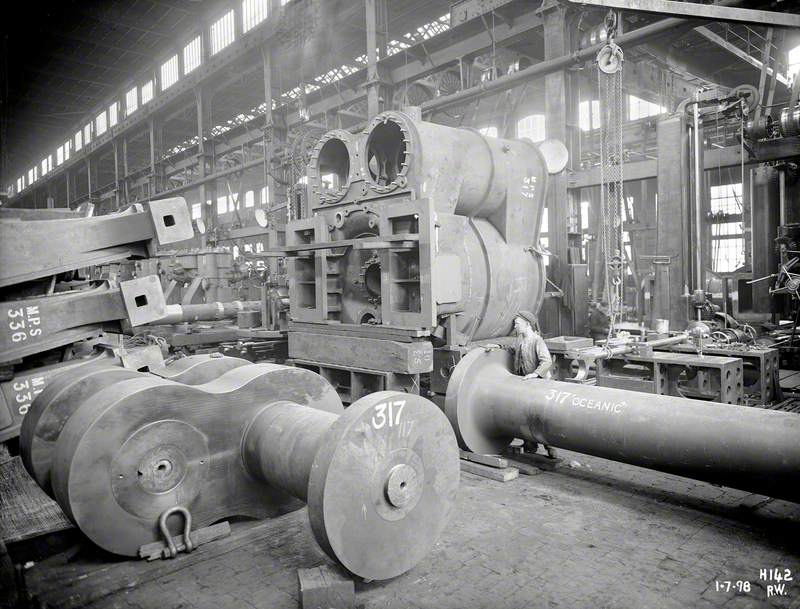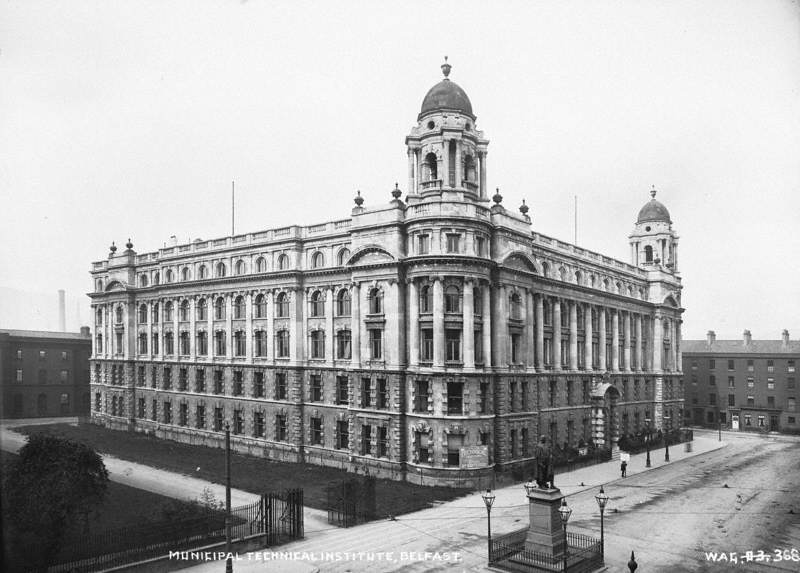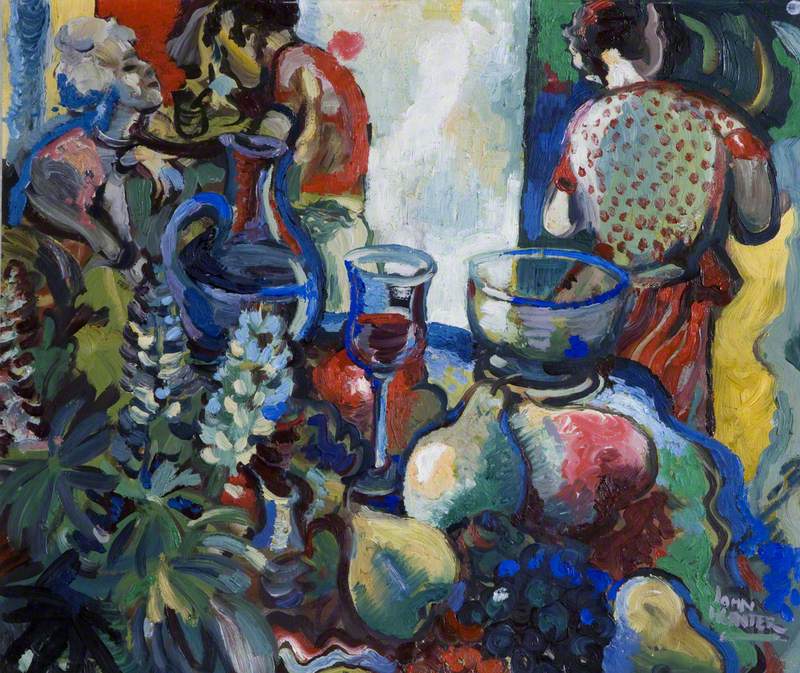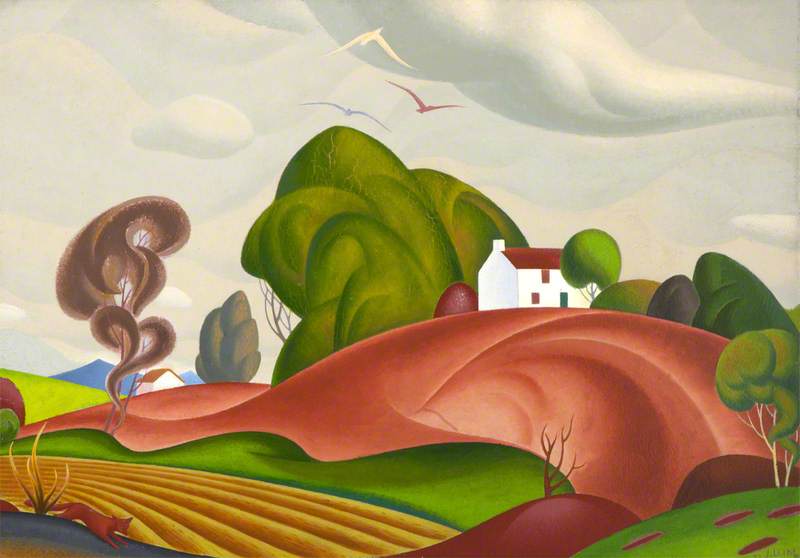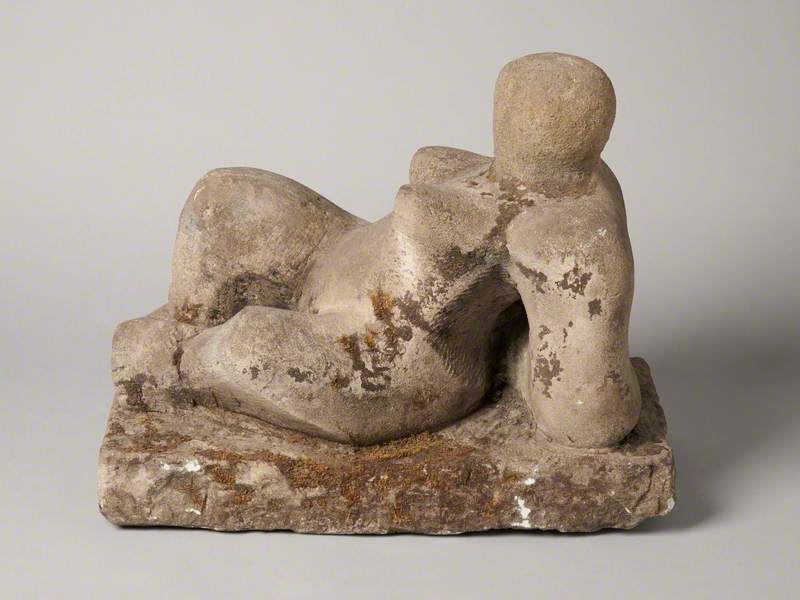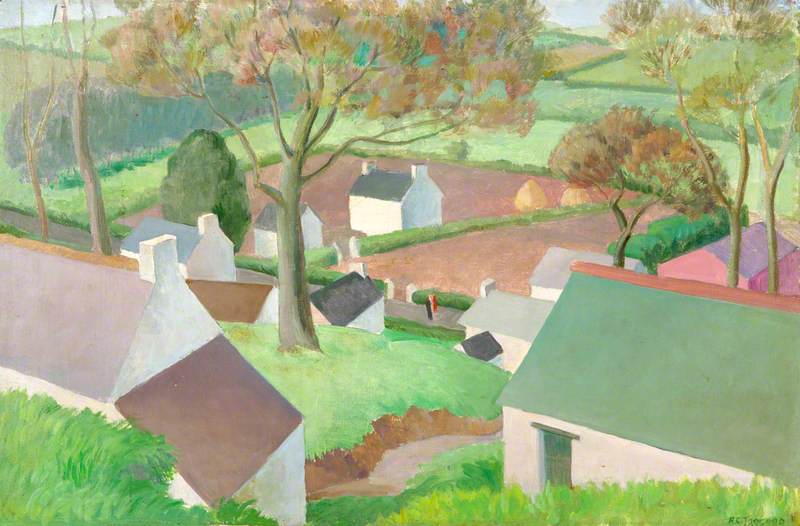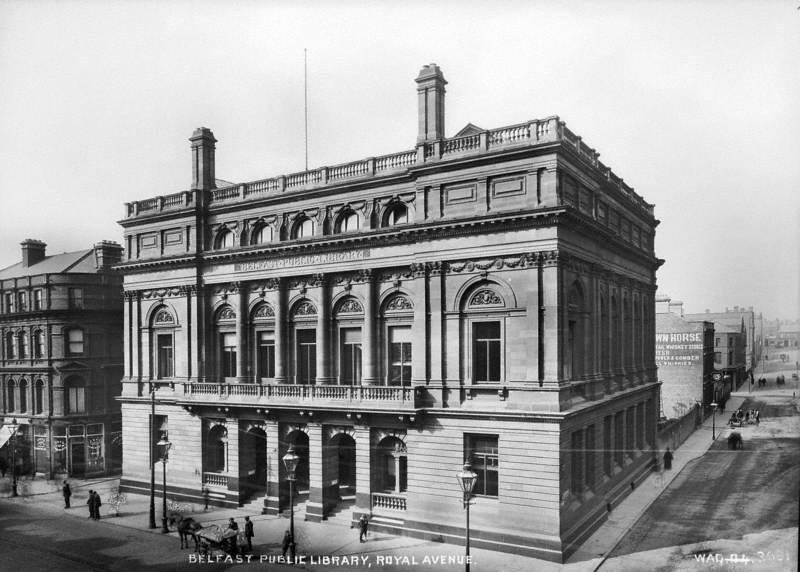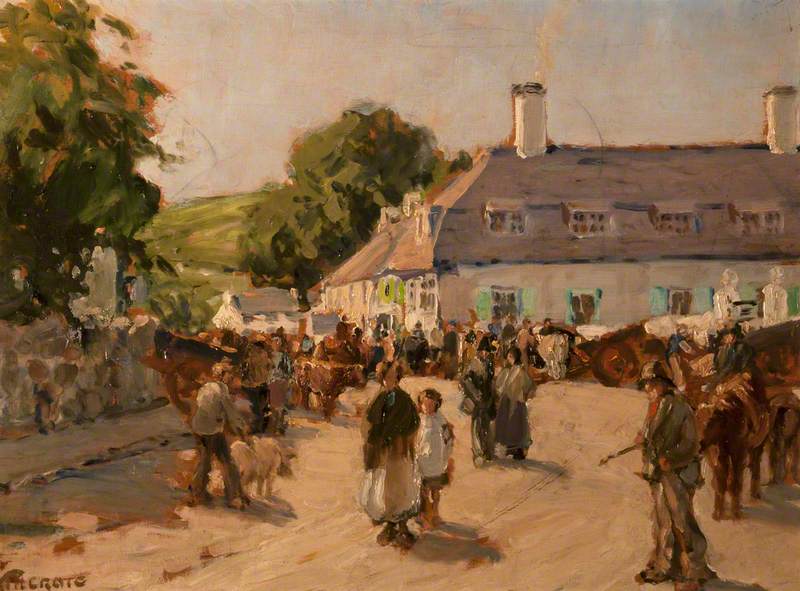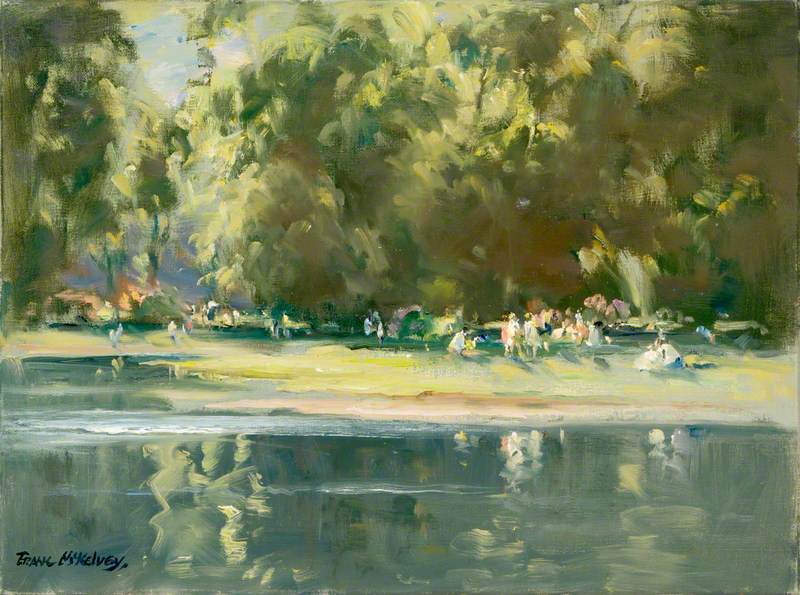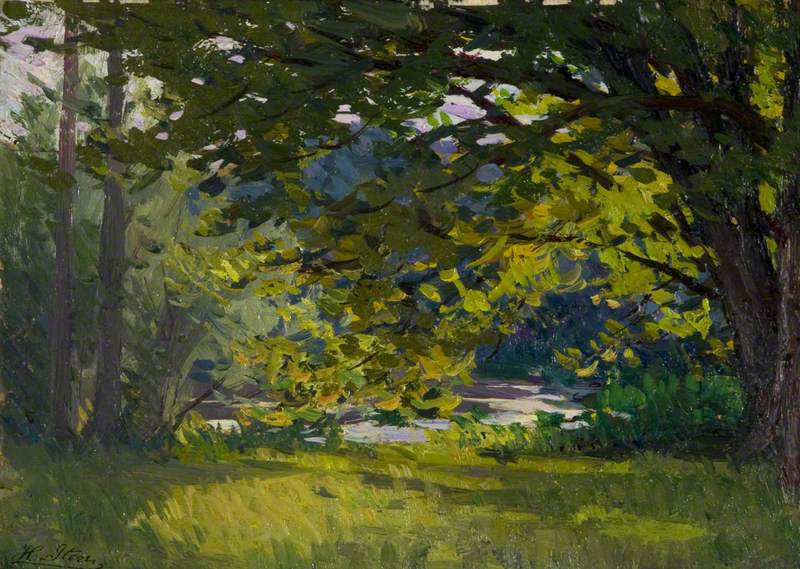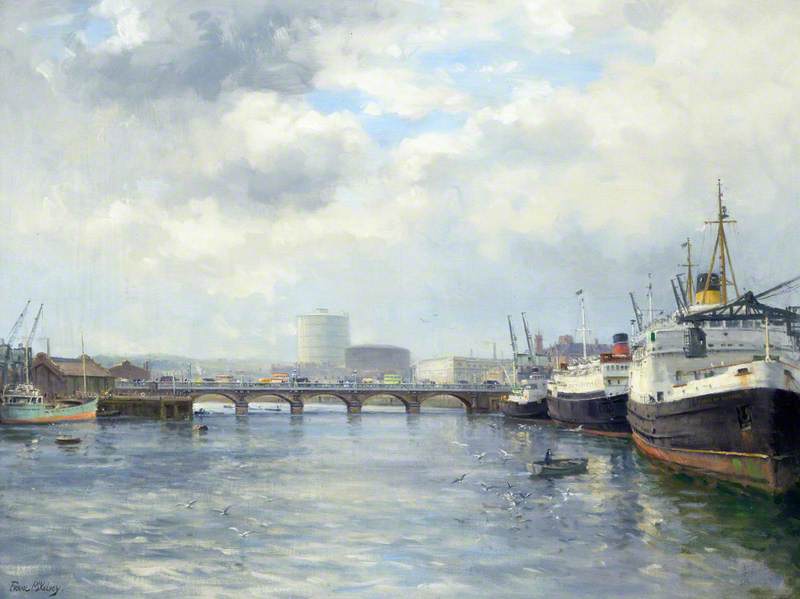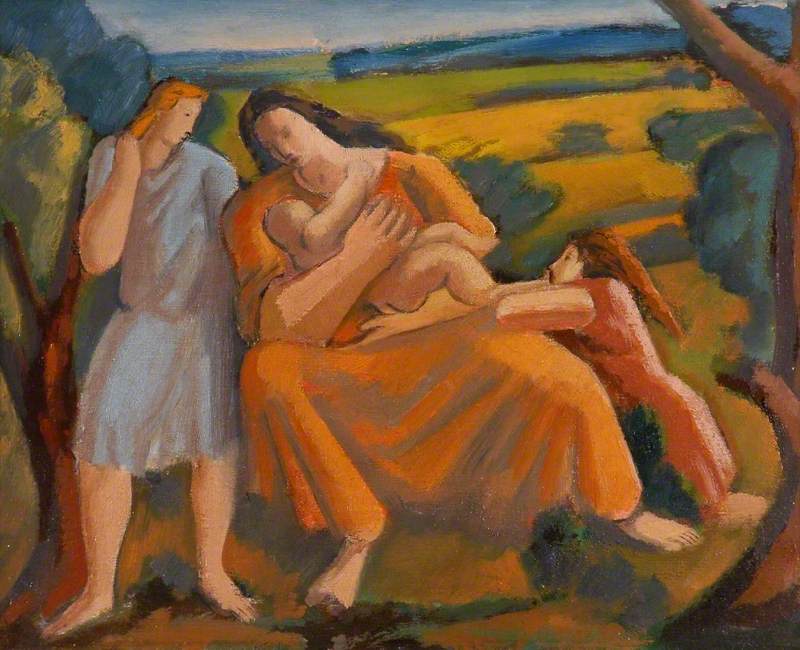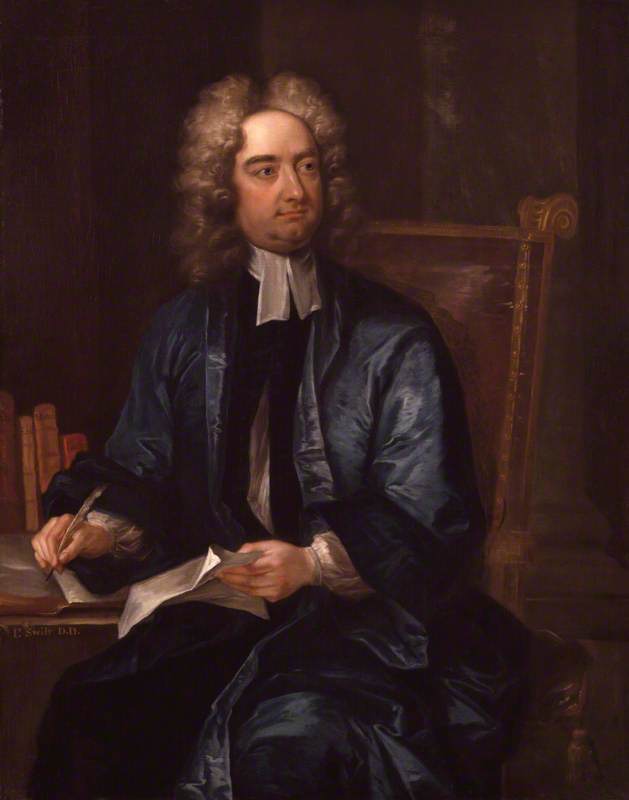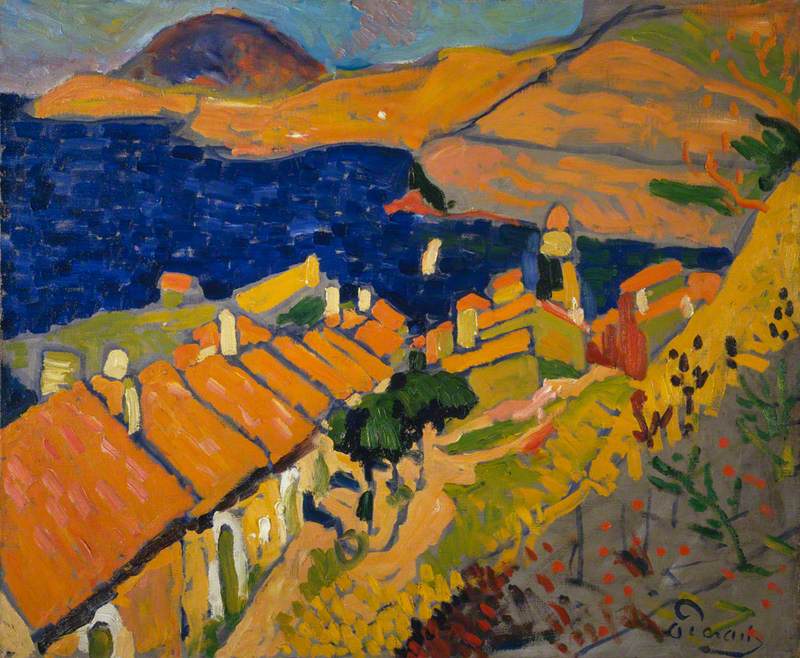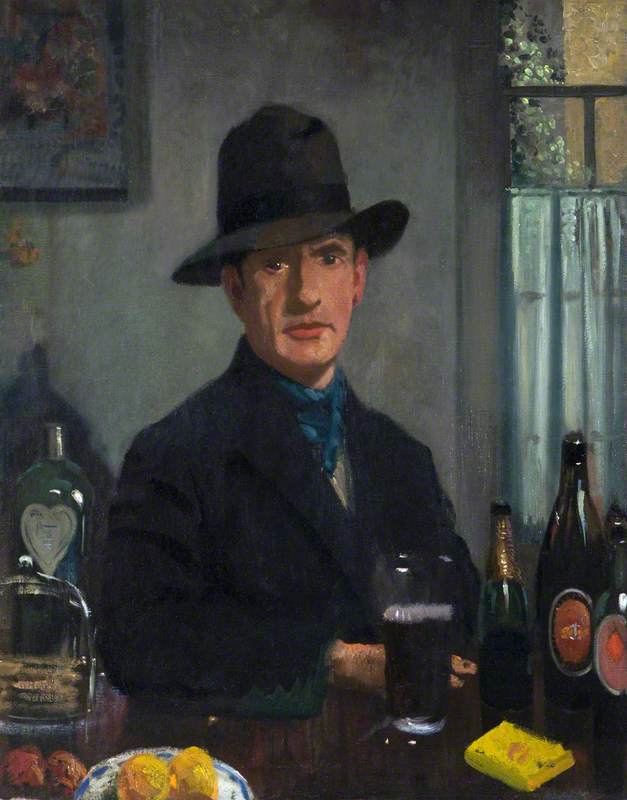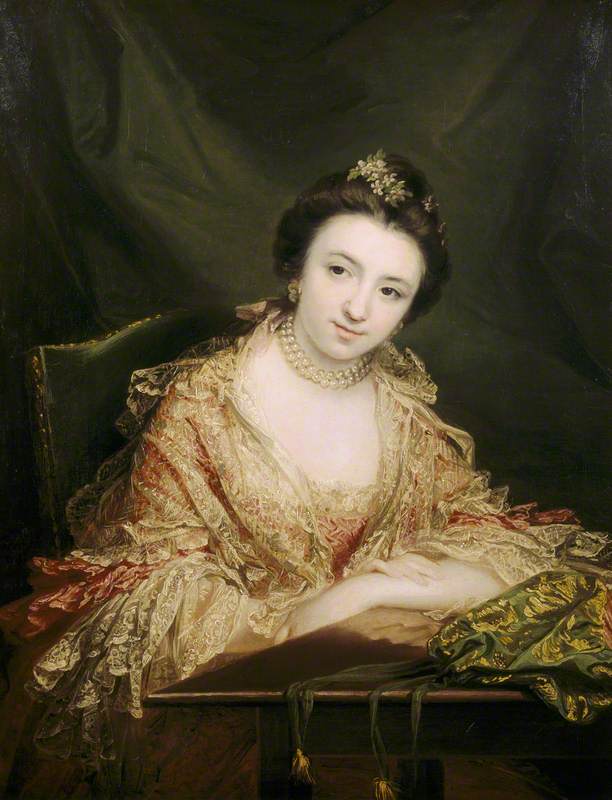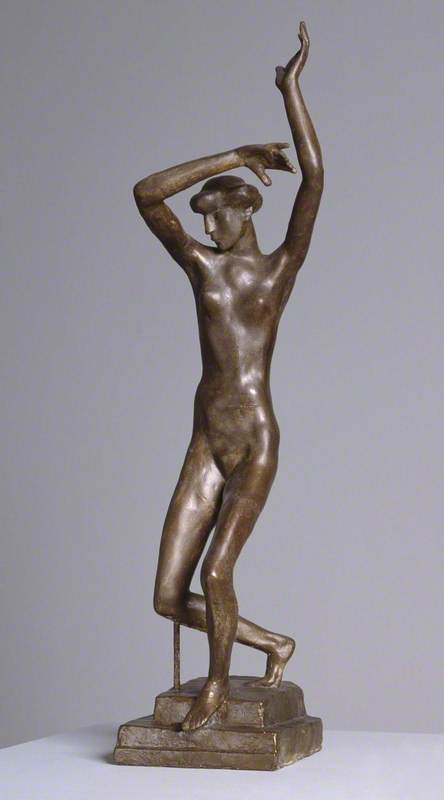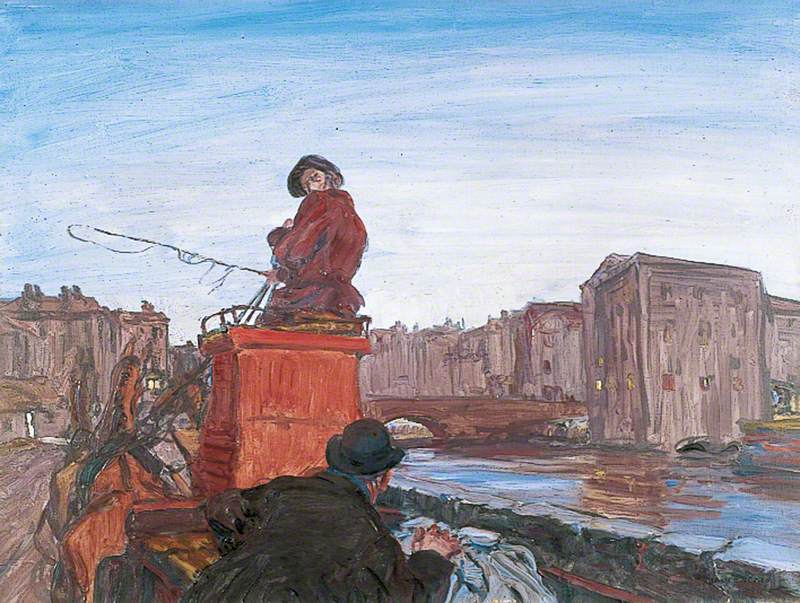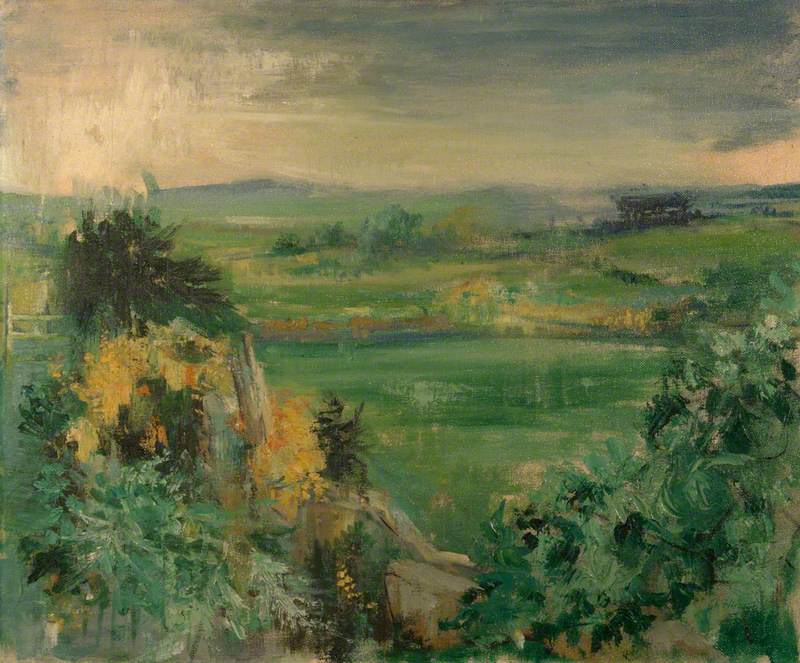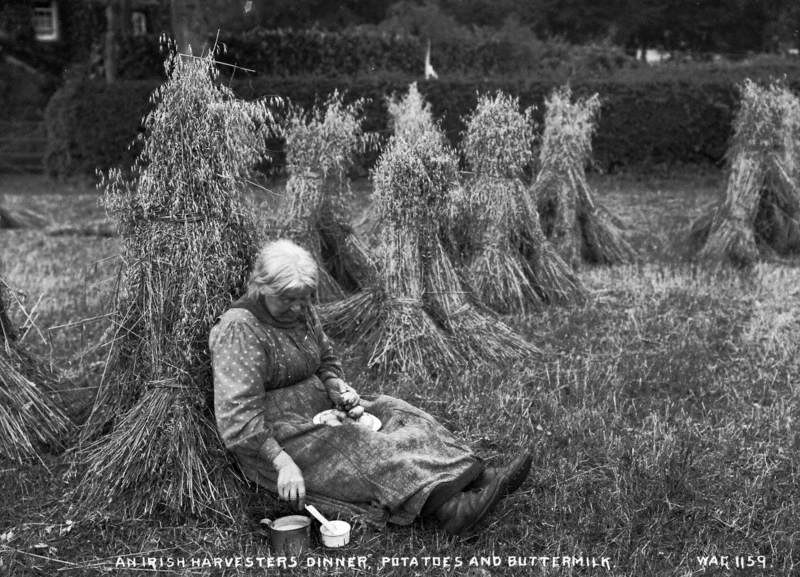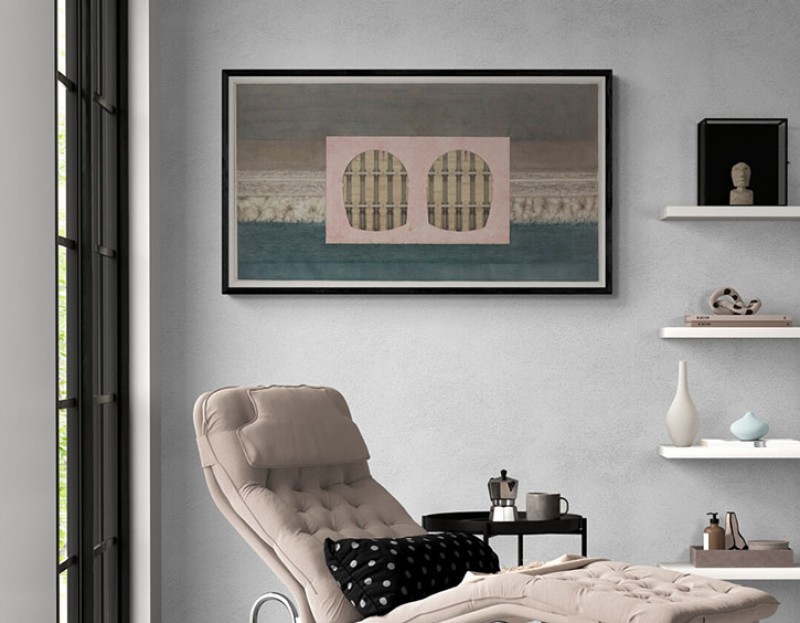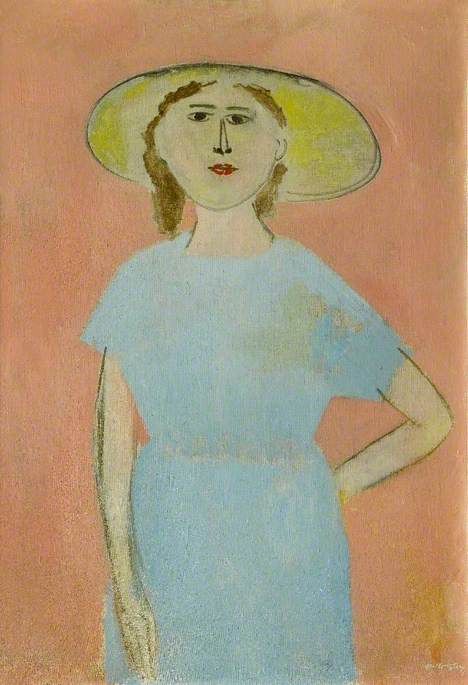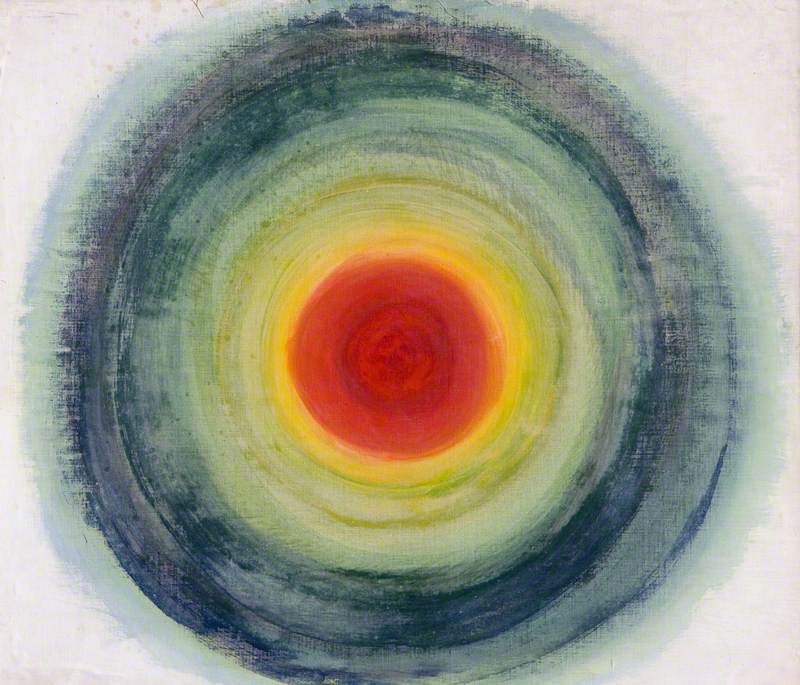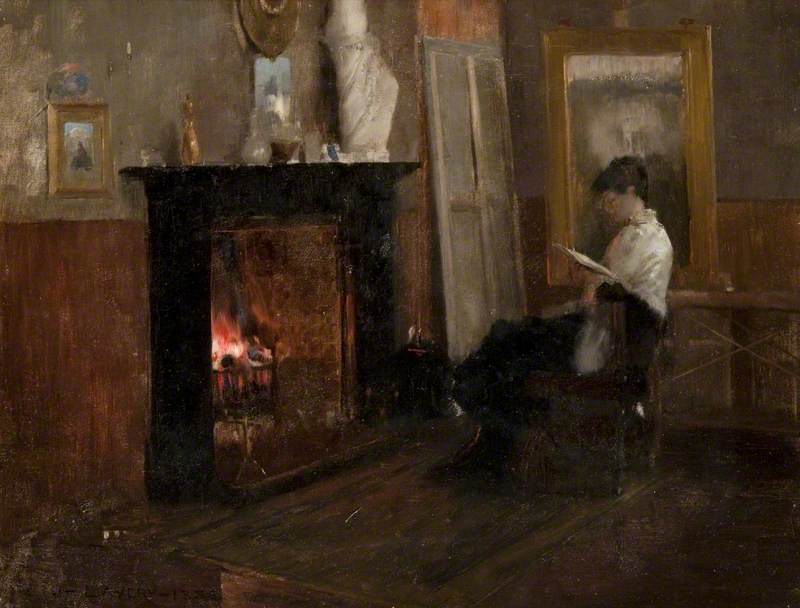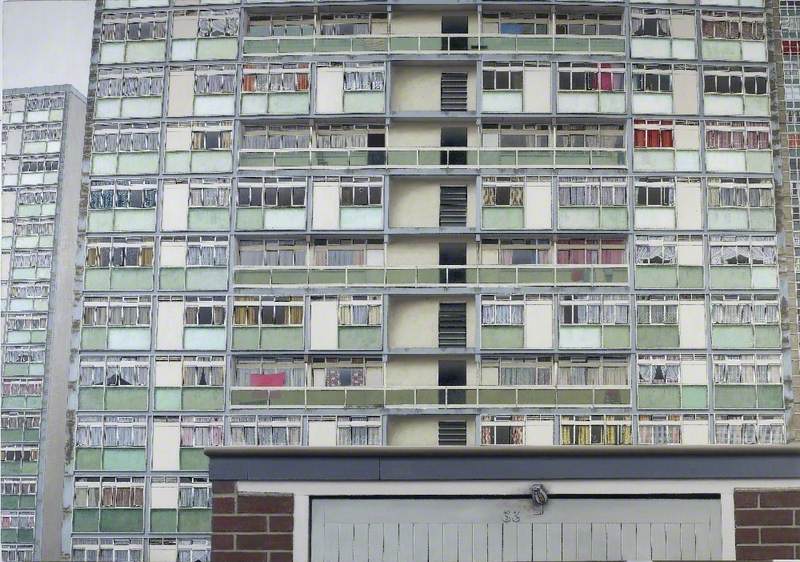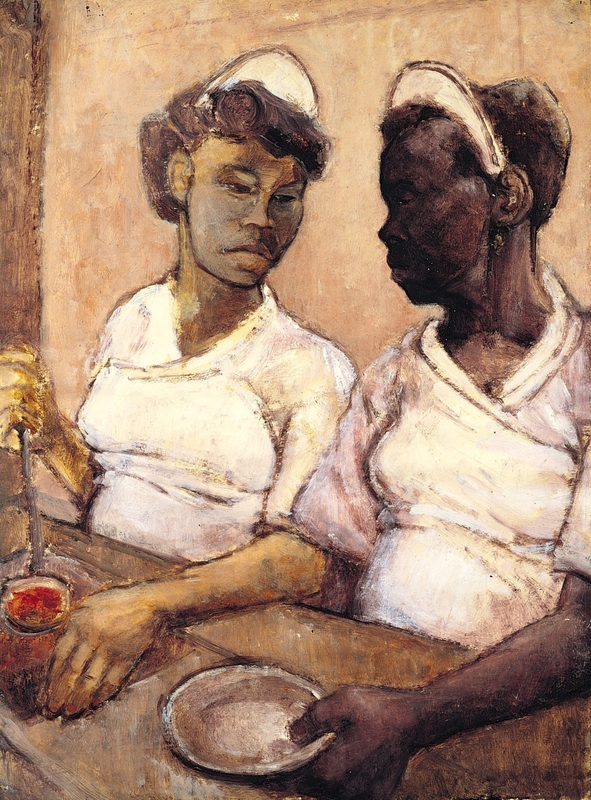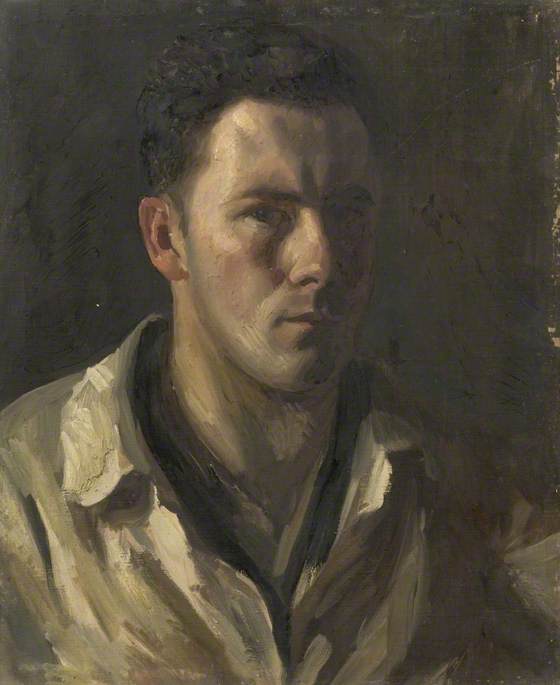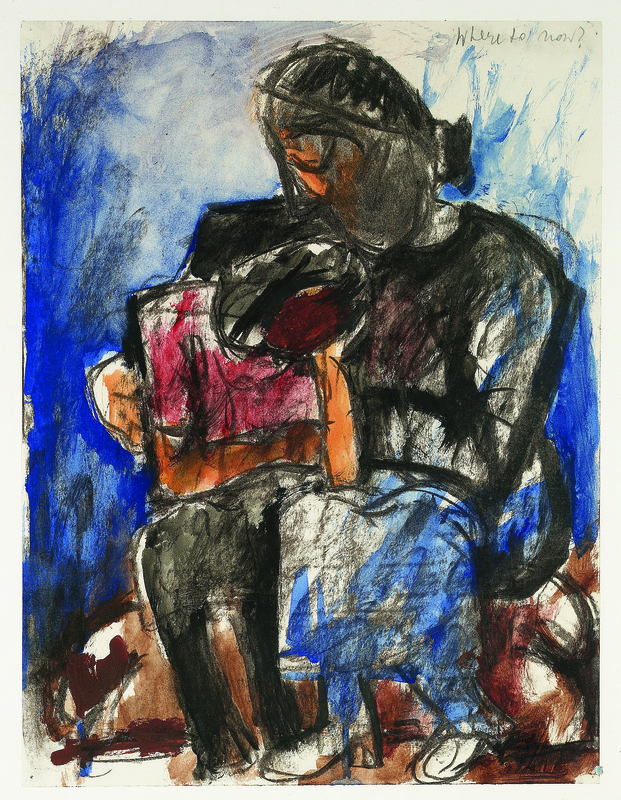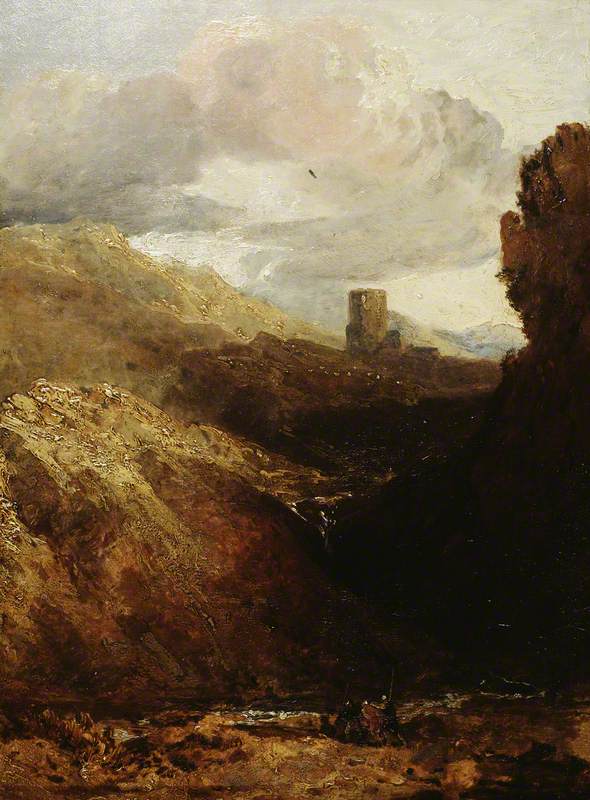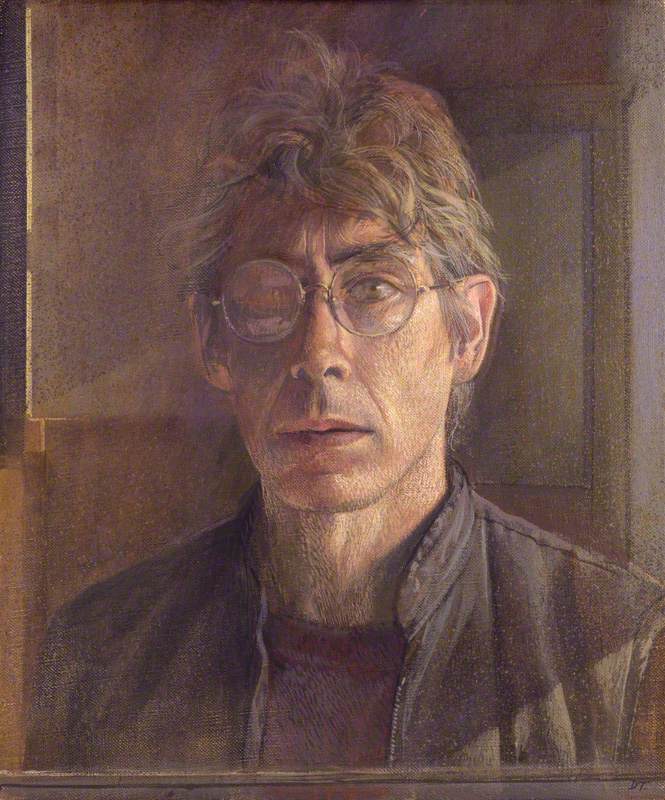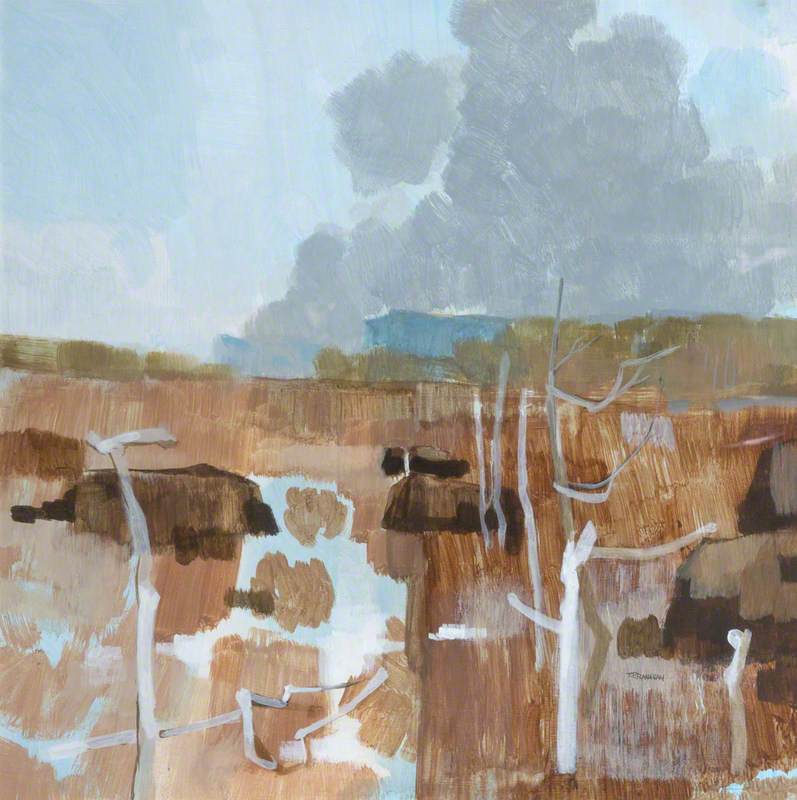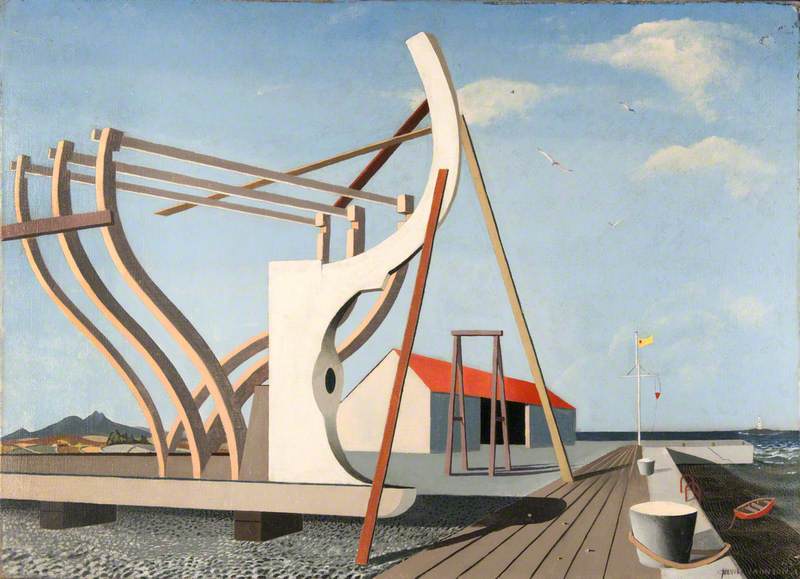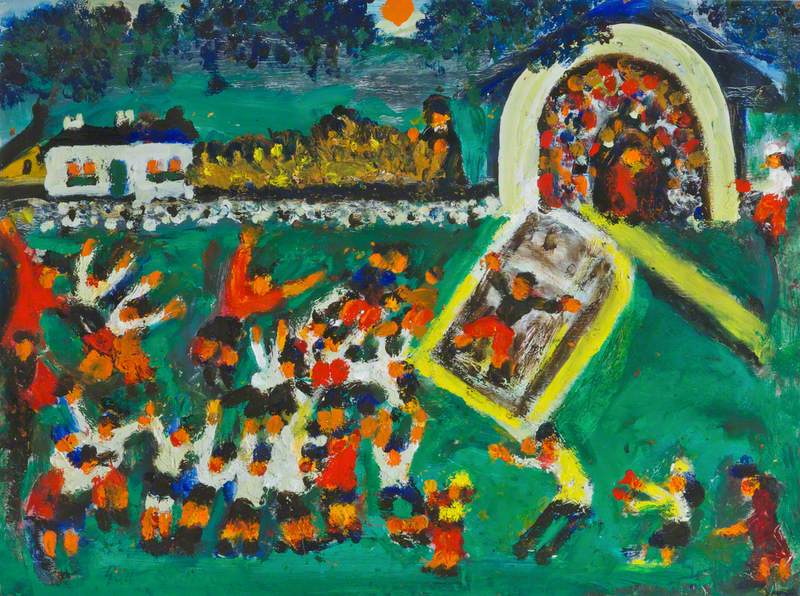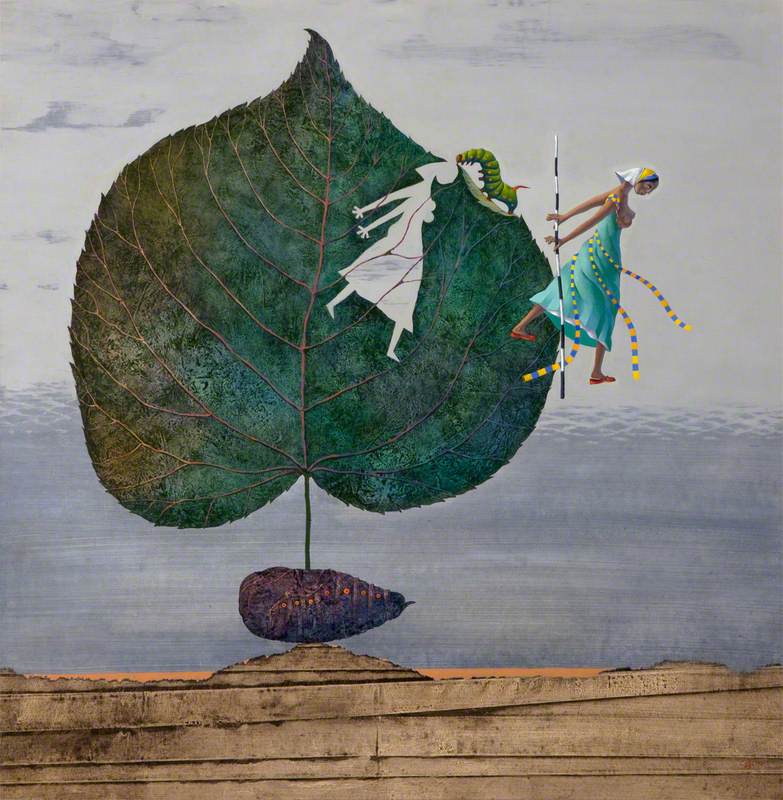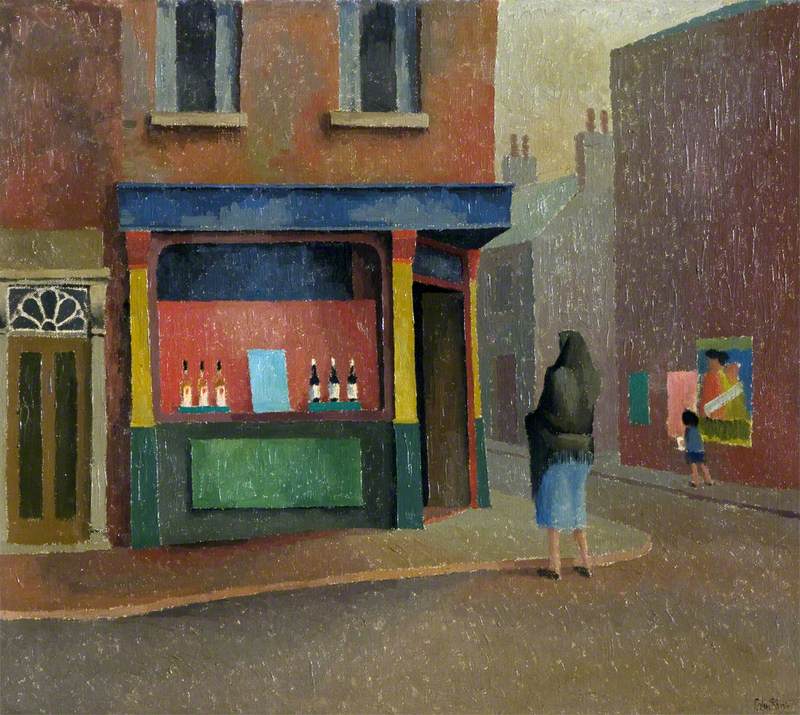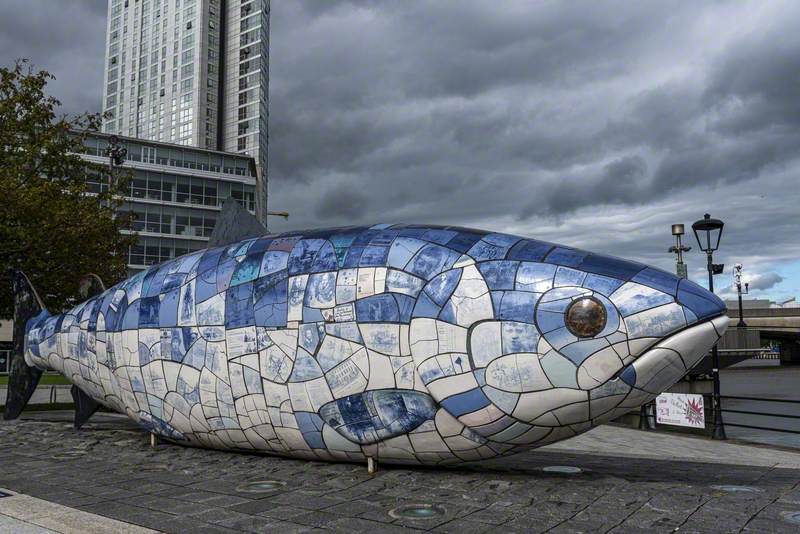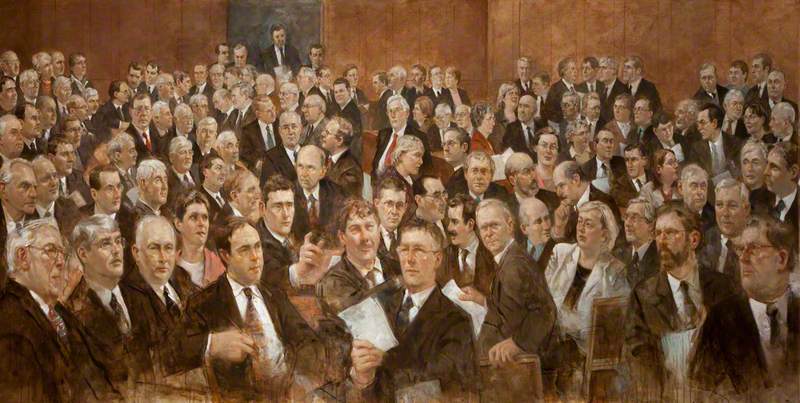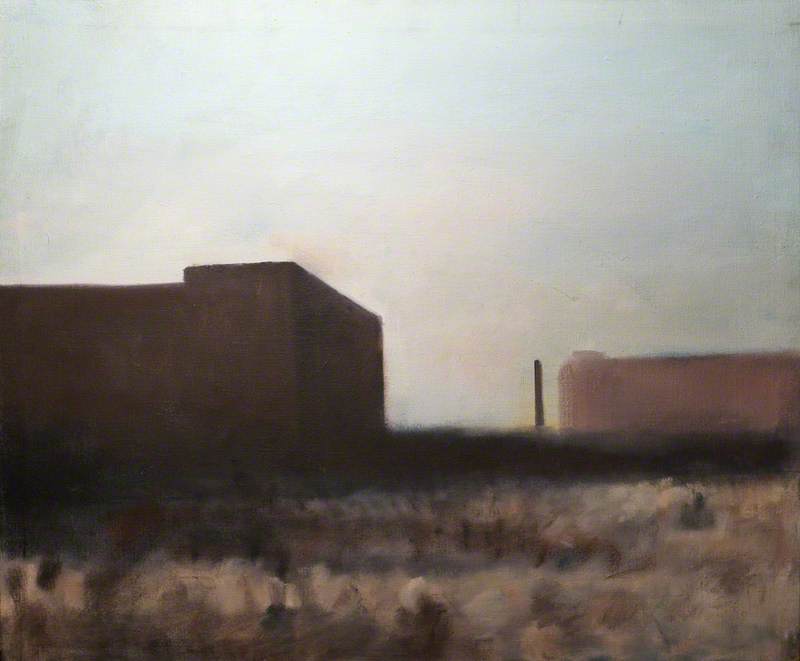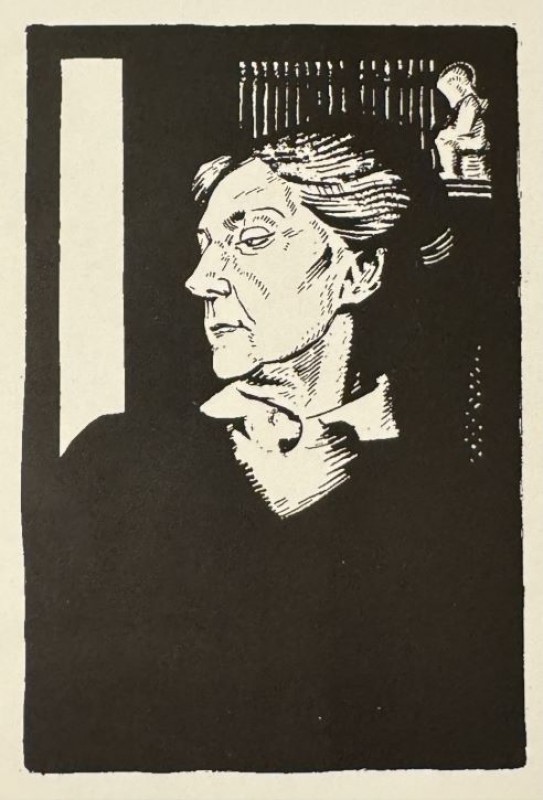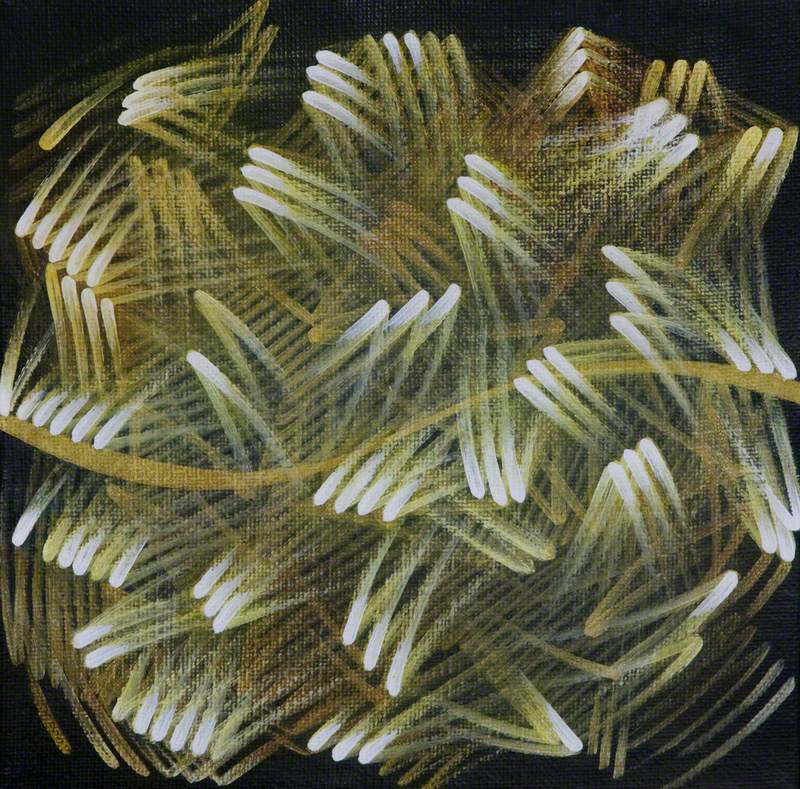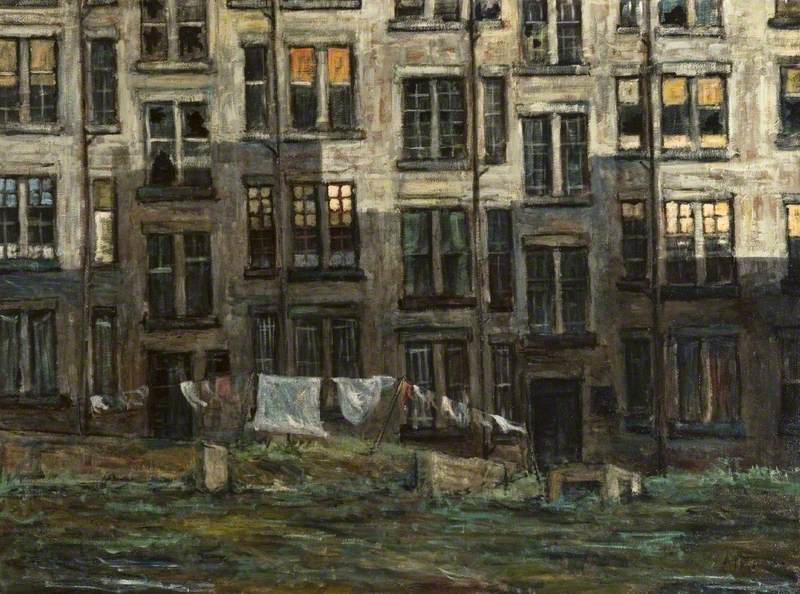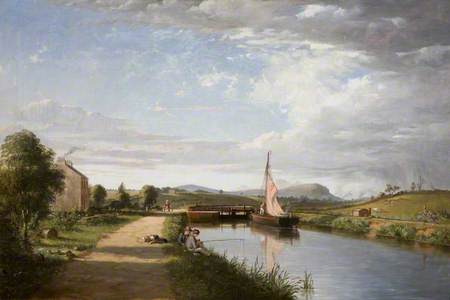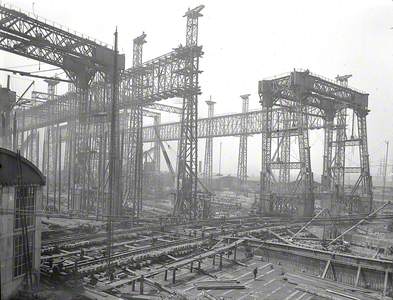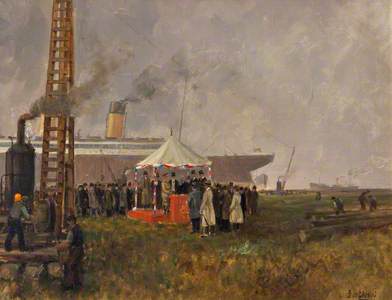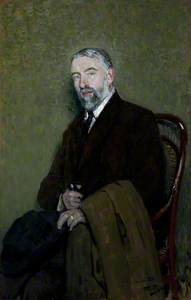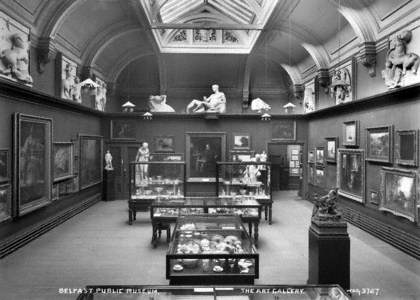Between 1841 and 1901 Belfast was the fastest growing of the ten largest cities in the United Kingdom and it also became the largest in Ireland, with city status granted in 1888. This exponential growth was largely brought about by a number of industries that operated successfully in Belfast, most famously shipbuilders such as Harland and Wolff, as well as manufacturers of rope and tobacco, and an internationally renowned linen industry which was the city's largest employer, with 43,000 engaged full-time or part-time in its production by 1911.
The pace of development transformed the physical appearance of the city – between 1880 and 1900, 50,000 new houses were built to cope with a population that had trebled in size between 1861 and 1911, rising from 121,602 to 386,947.
View of Sydenham, Belmont and Glenmachen
1864
J. H. Connop (active 1863–1867) 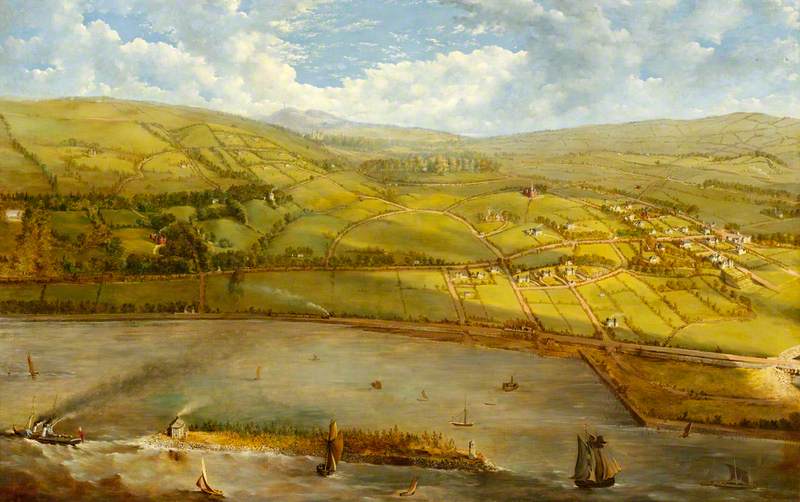
Despite the lack of any extensive visual record of the city in the late nineteenth century, it is obvious from paintings of Belfast by mid-nineteenth-century artists such as Hugh Frazer, James Howard Burgess and James Glen Wilson that the city remained small in scale.
In most images, the surrounding landscape and hills are more prominent and given more space and attention than the early signs of habitation and industry below them.
Even when the city began to grow with such remarkable speed in the late nineteenth century, its inhabitants often remained close to their rural roots. They often retained their particular customs and identity, and the dichotomy between their places of work and their domestic lives is a feature of the work of William Conor.
While Conor is arguably most famous for images of working-class women and children gathered around their homes or engaged in traditional domestic or leisure activities, he also made paintings and drawings of workers at the shipyards that endowed them with an almost heroic stature.
Irish Cottage Industries, Hand Embroidery on Linen in the Ards
William Alfred Green (1870–1958) 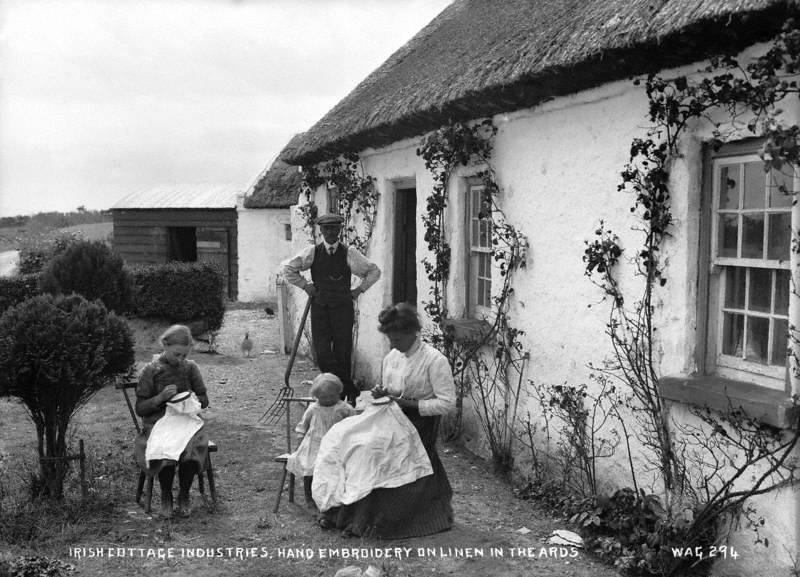
While the social and economic impact of Belfast's industrialisation was evident all around the city, the effect on its cultural life, particularly on the visual arts, was more gradual and subtle. Traditionally, few artists had worked in the city but by the 1880s and 1890s there was more demand for painters to document new public buildings, such as the City Hall, and notable local events.
The Proclamation of King Edward VII, Belfast Town Hall, 1901
William Gibbes Mackenzie (1857–1924) and Ernest E. Taylor (1863–1907) 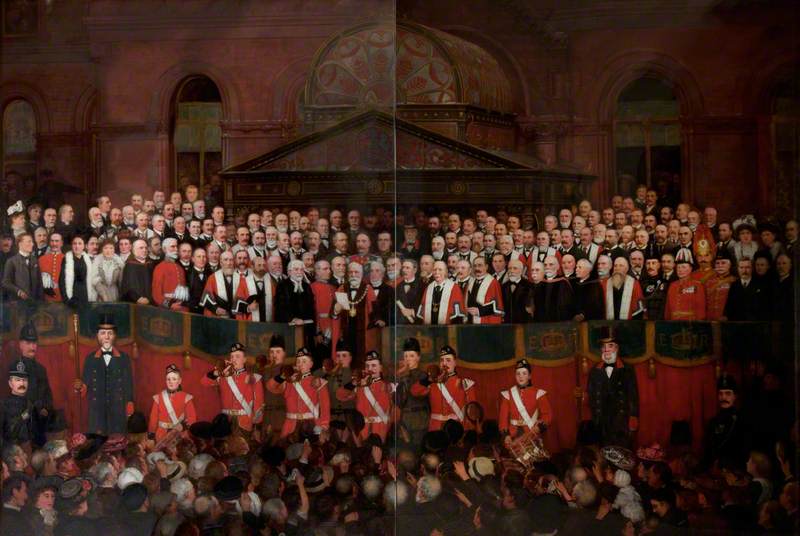
There were also opportunities for portraitists, including local painters such as Richard Hooke or William Foy, to record what John Hewitt described as 'the newly emergent clientele, the new industrialists... admiring themselves, who sought to have their features perpetuated in a no-nonsense style'.
Sir Otto Jaffe, Lord Mayor of Belfast (1899 & 1904)
John Haynes-Williams (1836–1908) 
It is notable that some of the images which have come to define the city at its industrial apogee were made by photographers such as Robert John Welch, who was employed by Harland and Wolff to record the shipyard and various aspects of the work there, or William Alfred Green, who was apprenticed to Welch.
Erection of main engine frames on bedplates in engine works
(Ship No. 317, 'Oceanic') 1898
Robert John Welch (1859–1936) and Harland & Wolff (founded 1861) 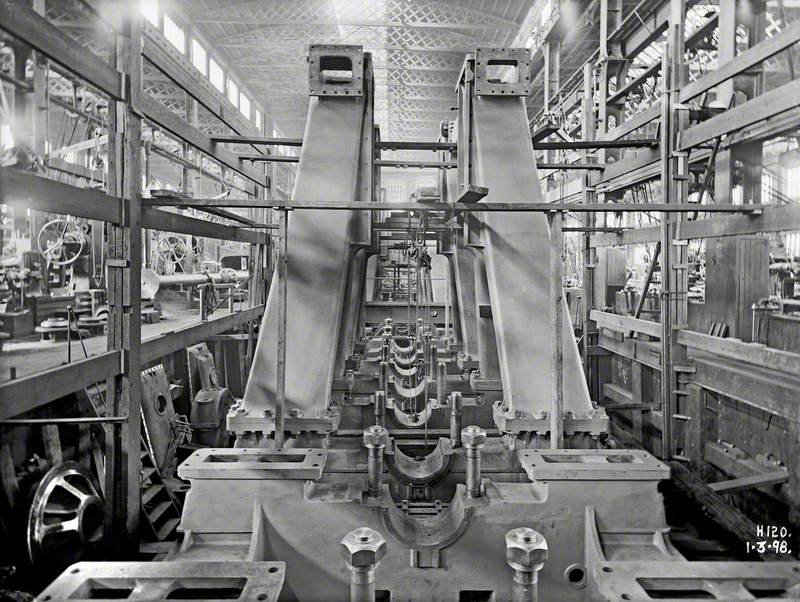
Perhaps unexpectedly, these can often seem to contain strikingly modernist tropes, full of bombastic mechanisation, surreal juxtapositions, jarring differences in scale and de-contextualised objects, striking a very different tone from paintings of industrial subjects in the early twentieth century.
Overhead view of deck looking aft from top of gantry
(Ship No. 433, 'Britannic') 1913
Robert John Welch (1859–1936) and Harland & Wolff (founded 1861) 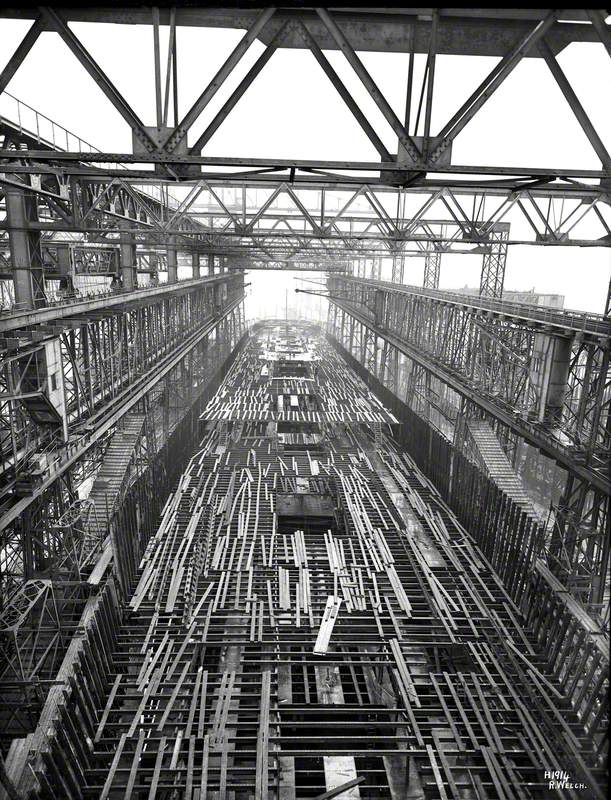
Gradually, however, a more home-grown artistic tradition began to emerge. The textile industry was the most notable consumer of design, so trained designers began to come to Belfast from other parts of the United Kingdom and also from Europe. Many of these were also keen artists who brought with them some knowledge of contemporary developments.
Hans Iten, who had studied painting in Switzerland and Paris, and Charles Middleton, a designer and amateur artist from Manchester, both arrived in Ulster in the early years of the twentieth century.
They quickly became involved with some of the exhibiting groups formed at this time, such as the Belfast Arts Society and the Ulster Arts Club, in response to the evolving interest in art in the city and the growing number of practising artists. John Hewitt noted the importance of 'damask designing in providing a prop to unrelated creative activity among Ulster artists from the first decades of the century.'
A design school was established in Belfast in 1849, replaced in 1870 by the Government School of Art, to train designers for local industries. By the early twentieth century it had become part of the Municipal Technical Institute and the access it provided for students from all backgrounds to courses in design and related skills had gradually become closer to a traditional art school education.
The access to art education and the increasing wealth of the city resulted in a number of scholarships for the most promising pupils. For a generation of young men and women, many of whom had worked in local industries or intended to take up design positions, these scholarships enabled them to study at art schools such as the Slade School, the Royal Academy Schools and the Royal College Art. They also provided opportunities to see notable historical collections as well as private galleries showing modern and contemporary art.
Although some of these students, such as William Scott and F. E. McWilliam, stayed in London and became notable figures in twentieth-century British art, the majority returned to Belfast and began to transform the local art scene.
These included John Hunter, Mercy Hunter, John Luke, George MacCann and Romeo Toogood and it is noticeable that a significant number of female students went from Belfast to study at London art schools.
At the same time as the opportunities for artists had been improving in Ulster, the access to art and its appreciation had also been transformed. The Free Library opened on Royal Avenue in 1888, one of the many new civic buildings constructed in the late nineteenth century to meet the requirements for leisure and education among the city's inhabitants.
Its top floor housed the Museum and Art Gallery and this was the venue for a remarkable exhibition of loan paintings organised by Sir Hugh Lane in 1906, which included works by Degas, Manet, Monet, Pissarro, Vuillard and Whistler, in the hope that a number of these might be acquired for the city's collection. Of these, only paintings by William Orpen and Henri Le Sidaner were purchased, but there was a perhaps surprising level of support from the local press as well as from art societies and the wider public.
The civic collection was also enhanced by the acquisition between 1929 and 1933, on the advice of English art critic Frank Rutter, of a remarkable collection of modern British art using funds from the sale of work donated to the city by Sir Robert Lloyd Patterson. The new collection included paintings by Stanley Spencer, William Roberts, Paul Nash and other leading contemporary British artists. It was housed in the Belfast Museum and Art Gallery, completed in 1929 beside the Botanical Gardens and Palmhouse, showcases of the city's Victorian splendour.
Entrance to Botanic Park and Stranmillis Road Belfast
William Alfred Green (1870–1958) 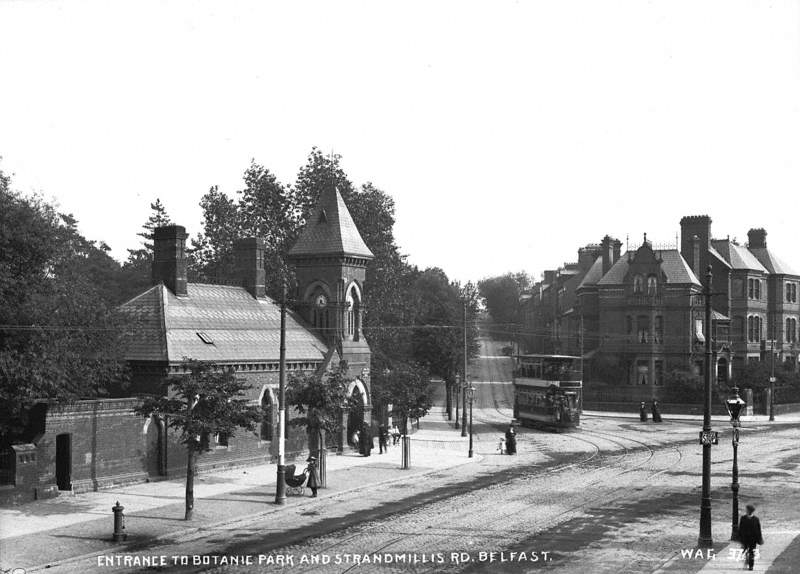
As the context in which young artists in Northern Ireland were working and exhibiting had developed by the 1930s, so the idea of a modernism that was particularly connected to Northern Ireland began to emerge. Artists such as John Lavery and Paul Henry had left Belfast as young men, and the most popular and successful painters in Northern Ireland were synonymous with a local landscape tradition that remained relatively traditional, despite the adoption of a plein air method of working and a quality of direct observation.
Artists such as James Humbert Craig, Frank McKelvey, Hans Iten and Maurice Wilks created the iconography of a rural and coastal idyll that largely ignored life within the industrial city and any social or economic problems of urbanisation.
The rural idyll continued to appeal to some of the younger artists who had returned to Belfast from London to make careers as professional artists. John Luke and Romeo Toogood produced work in a more stylised manner that demonstrated the influence of Cézanne as well as contemporary art theory.
But in the 1930s there were dramatic shifts in the local avant-garde, with younger artists based in Northern Ireland making work which not only embraced a radical modernism but also used the specific qualities of this modernism to examine the nature of the city both physically and socially. While the financial and cultural expansion of Belfast had enabled a home-grown artistic tradition to come into existence, a generation of artists growing up between the wars was about to examine the industrial city in the first throes of its decline.
Dickon Hall, art historian and Art UK Commissioning Editor (Northern Ireland)
This article was supported by Arts Council Northern Ireland
Further reading
Theo Snoddy, Dictionary of Irish Artists: Twentieth Century, Merlin, 2002
S. B. Kennedy, Irish Art and Modernism, Institute of Irish Studies, 1993
John Hewitt (ed. Ferguson and White), A North Light, Four Courts Press, 2013
